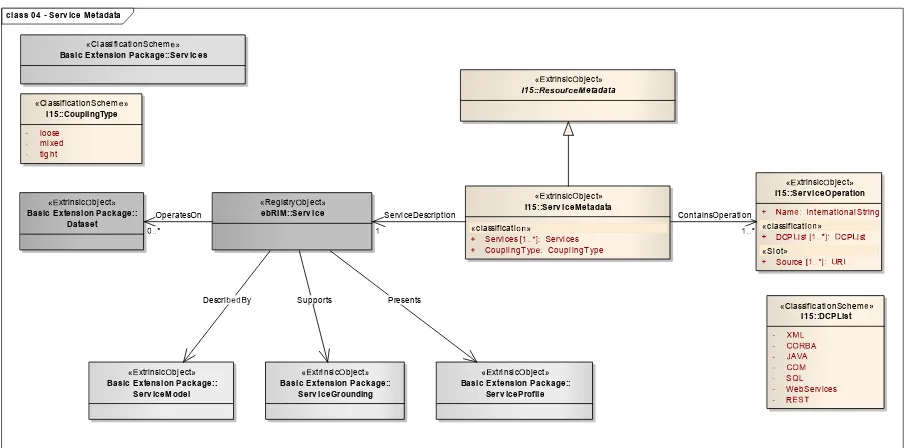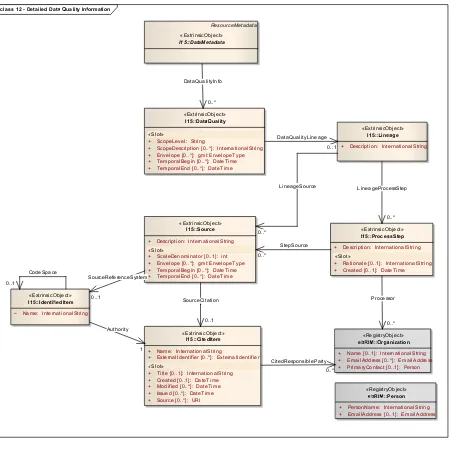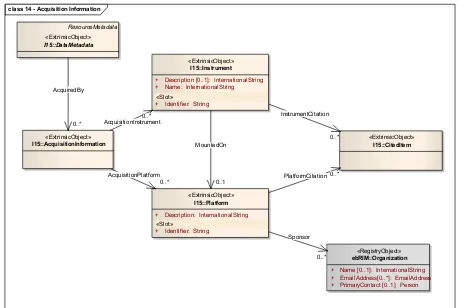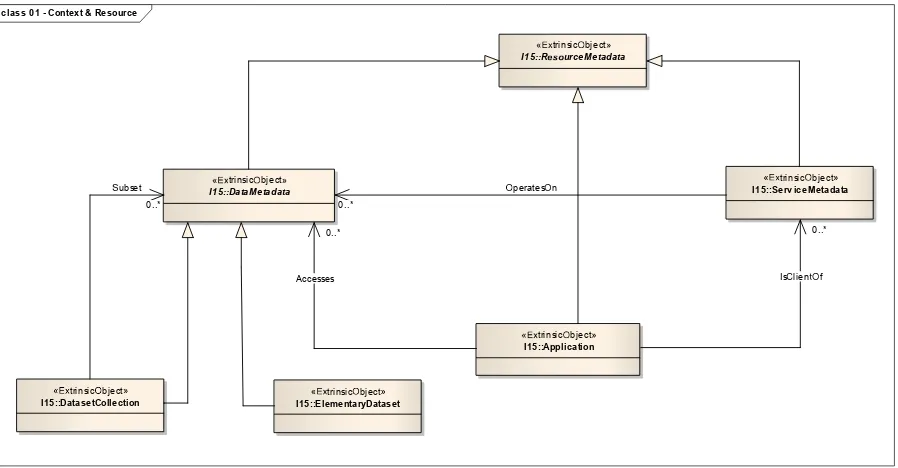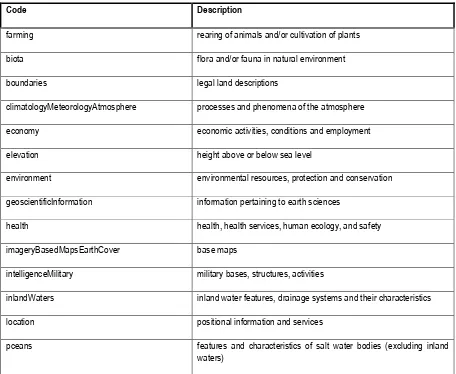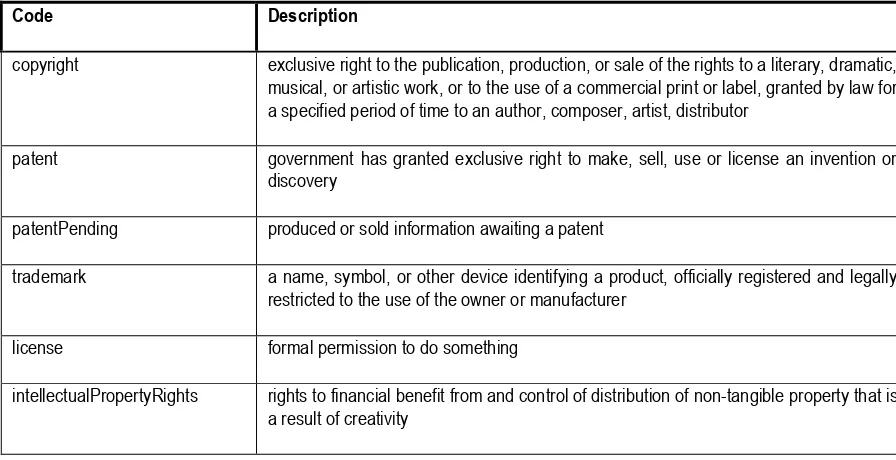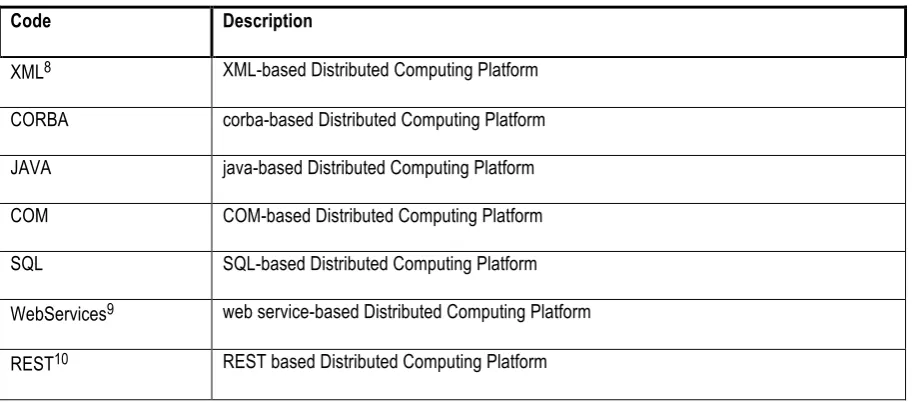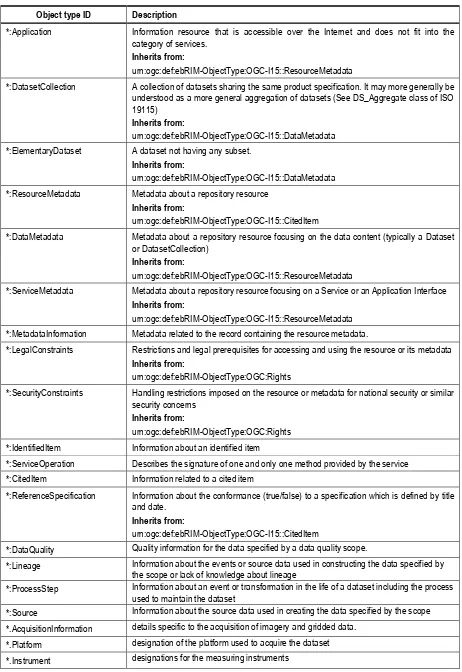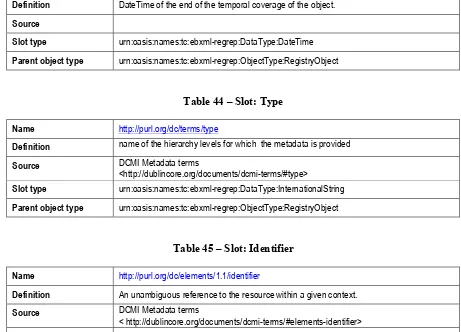Open Geospatial Consortium
Posted Date:2014-02-28
Approval Date: 2014-04-22
Publication Date: 2014-04-28
Reference URL for this document: http://www.opengis.net/doc/ISx/csw-ebrim-i15/1.0
Internal reference number of this document: OGC 13-084r2
Version: 1.0
Category: OGC® Extension Package Standard Editors: Uwe Voges, Frédéric Houbie, Nicolas Lesage, Marie-Lise Vautier
OGC I15 (ISO19115 Metadata) Extension Package of
CS-W ebRIM Profile 1.0
Extension Package Standard
Copyright notice
To obtain additional rights of use, visit http://www.opengeospatial.org/legal/.
Warning
This document is an OGC Member approved international standard. This document is available on a royalty free, non-discriminatory basis. Recipients of this document are invited to submit, with their comments, notification of any relevant patent rights of which they are aware and to provide supporting documentation.
Document type: OGC® Extension Package Standard Document subtype: Class 2 (ISO 19106)
Document stage: Approved
License Agreement
Permission is hereby granted by the Open Geospatial Consortium, ("Licensor"), free of charge and subject to the terms set forth below, to any person obtaining a copy of this Intellectual Property and any associated documentation, to deal in the Intellectual Property without restriction (except as set forth below), including without limitation the rights to implement, use, copy, modify, merge, publish, distribute, and/or sublicense copies of the Intellectual Property, and to permit persons to whom the Intellectual Property is furnished to do so, provided that all copyright notices on the intellectual property are retained intact and that each person to whom the Intellectual Property is furnished agrees to the terms of this Agreement.
If you modify the Intellectual Property, all copies of the modified Intellectual Property must include, in addition to the above copyright notice, a notice that the Intellectual Property includes modifications that have not been approved or adopted by LICENSOR.
THIS LICENSE IS A COPYRIGHT LICENSE ONLY, AND DOES NOT CONVEY ANY RIGHTS UNDER ANY PATENTS THAT MAY BE IN FORCE ANYWHERE IN THE WORLD.
THE INTELLECTUAL PROPERTY IS PROVIDED "AS IS", WITHOUT WARRANTY OF ANY KIND, EXPRESS OR IMPLIED, INCLUDING BUT NOT LIMITED TO THE WARRANTIES OF MERCHANTABILITY, FITNESS FOR A PARTICULAR PURPOSE, AND NONINFRINGEMENT OF THIRD PARTY RIGHTS. THE COPYRIGHT HOLDER OR HOLDERS INCLUDED IN THIS NOTICE DO NOT WARRANT THAT THE FUNCTIONS CONTAINED IN THE INTELLECTUAL PROPERTY WILL MEET YOUR REQUIREMENTS OR THAT THE OPERATION OF THE INTELLECTUAL PROPERTY WILL BE UNINTERRUPTED OR ERROR FREE. ANY USE OF THE INTELLECTUAL PROPERTY SHALL BE MADE ENTIRELY AT THE USER’S OWN RISK. IN NO EVENT SHALL THE COPYRIGHT HOLDER OR ANY CONTRIBUTOR OF INTELLECTUAL PROPERTY RIGHTS TO THE INTELLECTUAL PROPERTY BE LIABLE FOR ANY CLAIM, OR ANY DIRECT, SPECIAL, INDIRECT OR CONSEQUENTIAL DAMAGES, OR ANY DAMAGES WHATSOEVER RESULTING FROM ANY ALLEGED INFRINGEMENT OR ANY LOSS OF USE, DATA OR PROFITS, WHETHER IN AN ACTION OF CONTRACT, NEGLIGENCE OR UNDER ANY OTHER LEGAL THEORY, ARISING OUT OF OR IN CONNECTION WITH THE IMPLEMENTATION, USE, COMMERCIALIZATION OR PERFORMANCE OF THIS INTELLECTUAL PROPERTY.
This license is effective until terminated. You may terminate it at any time by destroying the Intellectual Property together with all copies in any form. The license will also terminate if you fail to comply with any term or condition of this Agreement. Except as provided in the following sentence, no such termination of this license shall require the termination of any third party end-user sublicense to the Intellectual Property which is in force as of the date of notice of such termination. In addition, should the Intellectual Property, or the operation of the Intellectual Property, infringe, or in LICENSOR’s sole opinion be likely to infringe, any patent, copyright, trademark or other right of a third party, you agree that LICENSOR, in its sole discretion, may terminate this license without any compensation or liability to you, your licensees or any other party. You agree upon termination of any kind to destroy or cause to be destroyed the Intellectual Property together with all copies in any form, whether held by you or by any third party.
Contents
Pagei. Abstract ... vii
ii. Keywords ... vii
iv. Document contributor contact points ... viii
vi. Document terms and definitions ... viii
vii. Foreword ... ix
Introduction ... x
1 Scope ... 11
2 Compliance ... 11
2.1 Requirements classes of the base specifications ... 12
2.2 Requirements classes of the I15 EP ... 12
2.2.1 Requirements class /conf/core: The Core ... 12
2.2.2 Requirements class /conf/extension: Extension for additional model elements ... 12
2.3 Conformance requirements ... 13
3 Normative references ... 14
4 Terms and definitions ... 15
4.1 dataset ... 16
4.2 dataset collection ... 16
5 Conventions ... 16
5.1 Abbreviated terms ... 16
5.2 UML notation ... 17
5.3 Namespace prefix conventions ... 17
5.4 Presentation of requirements and recommendations ... 17
6 Catalog infrastructure overview (Enterprise Viewpoint) ... 18
6.1 Application domain ... 18
6.2 Essential use cases ... 18
6.2.1 Publish metadata ... 20
6.2.2 Discover metadata ... 21
6.2.3 Harvest metadata ... 21
7 The I15 Registry Package ... 22
7.1 Purpose ... 22
7.2 Modelling Notations and Conventions ... 23
7.2.1 ebXML Slot Types Definition ... 24
7.3 The I15 model ... 27
7.3.1 Resource Metadata ... 27
7.3.2 Keyword and Thesaurus information ... 28
7.3.3 Constraint Information ... 31
7.3.4 Browse graphic information ... 32
7.3.5 Citation information ... 32
7.3.6 Metadata Point of Contact ... 33
7.3.7 QualityConformance Information ... 34
7.3.8 Reference System information ... 34
7.3.9 Quality information ... 35
7.3.11 Resource metadata context ... 37
8 Classification schemes ... 38
8.1 Topic categories ... 38
8.2 Cited Responsible Party ... 39
8.3 Spatial representations ... 40
8.4 Character sets ... 40
8.5 KeywordSchemeUntyped ... 42
8.6 KeywordSchemeDiscipline ... 42
8.7 KeywordSchemePlace ... 43
8.8 KeywordSchemeStratum ... 43
8.9 KeywordSchemeTemporal ... 43
8.10 KeywordSchemeTheme ... 44
8.11 Restriction codes ... 44
8.12 Restriction types ... 45
8.13 Classification codes ... 45
8.14 DCPList ... 46
8.15 Coupling types ... 47
8.16 Metadata standard name and version ... 47
8.17 Format name and version ... 48
8.18 Services taxonomy ... 48
9 Classification nodes ... 48
9.1 Objects types ... 48
9.2 Association types ... 50
10 Normative I15 Model ... 53
10.1 Overview ... 53
10.1.1 Introduction ... 53
10.1.2 Notation ... 54
10.2 I15 Slots ... 55
10.3 Data dictionary ... 60
10.3.1 Resource Metadata ... 60
10.3.2 Data Metadata ... 64
10.3.3 Service Metadata ... 65
10.3.4 Application ... 67
10.3.5 Constraint Information ... 68
10.3.6 ReferenceSystem information ... 69
10.3.7 Citation information ... 69
10.3.8 Browse graphic information ... 71
10.3.9 Quality Information ... 71
10.3.10 QualityConformance Information ... 74
10.3.11 Acquisition Information ... 75
11 ISO 19115/19115-2/19119 mapping ... 77
11.1 Introduction ... 77
11.2 Registration of a metadata record ... 77
11.2.1 Preamble ... 77
11.2.2 Instance of MetadataInformation for the resource ... 78
11.2.3 Instance of MetadataInformation for the parent resource ... 79
11.2.4 Instance of ResourceMetadata ... 79
11.3 Registration of the information resources ... 80
11.3.2 Registration of ElementaryDataset, DatasetCollection or
Application ... 81
11.3.3 Registration of Service or Application ... 85
11.4 Registration of data quality information ... 87
11.4.1 Preamble ... 87
11.4.2 Registration of Quality Information ... 87
11.4.3 Registration of QualityConformanceResults ... 91
11.4.4 Registration of Acquisition information ... 91
11.5 Registration of Constraint Information ... 94
11.6 Registration of Reference System Information ... 95
11.7 Registration of Geographic and Temporal Extent Information ... 95
11.8 Registration of Citation and Responsible party information ... 97
11.8.1 Registration of Citation information ... 97
11.8.2 Registration of Responsible Party information ... 97
11.9 Registration of Graphic Overview information ... 97
11.10 Registration of Descriptive Keywords information ... 98
12 Alignment with OGC CSW-ebRIM Registry Service ... 101
12.1 HTTP Binding ... 101
12.1.1 SOAP Support ... 101
12.2 ebXML Information Model ... 101
12.2.1 Management of spatial references ... 101
12.2.2 Multiplicity of slots ... 101
12.2.3 Application schemas ... 102
12.2.4 Semantic issues ... 102
12.3 Operations ... 102
12.3.1 Specificities of the GetRecords operation ... 102
12.3.2 Specificities of the GetRecords/GetRecordsById full response ... 103
12.3.3 Specificities of the GetCapabilities operation ... 104
12.3.4 Specificities of the GetRepositoryItem operation ... 104
12.3.5 Specificities of the Harvest operation ... 104
12.3.6 Error handling ... 105
12.4 CSW record binding ... 105
12.5 Security considerations ... 105
12.6 Native language support ... 105
12.7 Distributed Search ... 105
Annex A: Abstract Test Suite (normative) ... 106
A.1.1. Test: conf/core/SOAP1.2 ... 106
A.1.2. Test: /conf/core/packageMembership ... 106
A.1.3. Test: /conf/core/GetRecords ... 106
A.1.4. Test: /conf/core/FullResponse ... 107
A.1.5. Test: /conf/core/ISO2I15Mappings ... 107
A.2.1. Test: /conf/ extension/packageMembership ... 108
A.2.2. Test: /conf/extension/GetRecords ... 108
A.2.3. Test: /conf/extension/FullResponse ... 108
A.2.4. Test: /conf/extension/ISO2I15Mappings ... 109
A.2.5. Test: /conf/extension/Harvest ... 109
Annex B: Examples ... 110
B.1 Data Example ... 110
B.1.2 ebXML 3.0 encoding ... 116
B.2 Service Example ... 123
B.2.1 ISO19139 encoding ... 123
B.2.2 ebXML 3.0 encoding ... 127
Annex C: Revision history ... 133
Figures
PageFigure 1: Overall system use cases 19
Figure 2: Publish metadata 20
Figure 3: Discover metadata 21
Figure 4: Harvest metadata 21
Figure 5: Extension Packages 23
Figure 6 – Resource Metadata 27
Figure 7 – Keyword and Thesaurus information 28
Figure 8 – Data Metadata 29
Figure 9 – Service Metadata 30
Figure 10 – Application 31
Figure 11 – Constraint Information 32
Figure 12 - Browse Graphic information 32
Figure 13 – Citation 33
Figure 14 – Metadata Point of Contact 33
Figure 15 – QualityConformanceInformation 34
Figure 16 – Reference System Information 35
Figure 17 – Quality Information 36
Figure 18 – Acquisition information 36
Figure 19 – Resource Metadata Context 37
Figure 20: ResourceMetada classified by keywords in different keyword classification
i.
Abstract
The OGC Catalogue Services 2.0 specification (OGC 07-006r1) establishes a general framework for implementing catalogue services that can be applied to meet the needs of stakeholders in a wide variety of domains.
The ebRIM application profile (OGC 07-110r4) is based on the HTTP protocol binding described in Clause 10 of the Catalogue 2.0 specification; it qualifies as a ‘Class 2’ profile under the terms of ISO 19106 since it includes extensions permitted within the context of the base specifications, some of which are not part of the ISO 19100 series of geomatics standards. The ebRIM application profile also includes a Basic extension package (OGC 07-144r4) of the OASIS ebXML Registry Information Model (ebRIM) providing artefacts of general utility in the geomatics domain.
This document provides an extension package aligned with the ebRIM application profile of CS-W for the cataloguing of ISO 19115, ISO19115-2 and ISO 19119 compliant metadata. It was initially produced during the ESA HMA (Heterogeneous Missions Accessibility) initiative [HMA] and related projects. Some input came from the OGC OWS9 initiative.
This document supersedes the former document OGC Cataloguing of ISO Metadata (CIM) using the ebRIM profile of CS-W, OGC 07-038r3 (Version: 0.1.12).
ii.
Keywords
The following are keywords to be used by search engines and document catalogues. ogcdoc, OGC document, OGC Catalogue Services, catalogue, ebRIM, HMA, extensionPackage, ISO19115, ISO19119, csw:Record, filter, RIM, GetCapabilities, GetDomain, GetRecords, GetRecordById, GetRepositoryItem, metadata, spatial, ESA, SAFE, HMA-S
iii.
Preface
Attention is drawn to the possibility that some of the elements of this document may be the subject of patent rights. The Open Geospatial Consortium shall not be held responsible for identifying any or all such patent rights.
iv.
Document contributor contact points
All questions regarding this document should be directed to the editor or the contributors:
Name Organization
Uwe Voges – u.voges<at>conterra.de CON TERRA (Germany)
Frédéric Houbie – frederic.houbie<at>geomatys.com GEOMATYS (France) Maria Rosaria Barone - mariarosaria.barone<at>intecs.it INTECS (Italy) Lorenzo Bigagli – lorenzo.bigagli<at>cnr.it CNR (Italy)
David Burggraf – dsburggraf<at>gmail.com GALDOS (Canada)
Udo Einspanier – u.einspanier<at>conterra.de CON TERRA (Germany) Nicolas Lesage – nicolas.lesage<at>ign.fr IGN (France)
Marie-Lise Vautier – marie-lise.vautier<at>ign.fr IGN (France) Marcellin Prudham – marcellin.prudham<at>ign.fr IGN (France) Gilles Cebelieu – gilles.cebelieu<at>ign.fr IGN (France) Didier Richard – didier.richard<at>ign.fr IGN (France)
Patrick Floissac - patrick.floissac<at>magellium.fr MAGELLIUM (France) Jef Vanbockryck - jef.vanbockryck<at>cronos.be CRONOS (Belgium) Yaman Ustuntas - yaman.ustuntas<at>cronos.be CRONOS (Belgium)
v.
Changes to the OGC Abstract Specification
The OGC®Abstract Specification does not require any changes to accommodate the technical content of this document.
vi.
Document terms and definitions
vii.
Foreword
This document depends primarily on the following base standards and specifications: OGC Catalogue Services Specification 2.0, with Technical Corrigendum 2 (OGC
07-006r1)
OGC™ CSW-ebRIM Registry Service - Part 1: ebRIM profile of CSW, version 1.0.1, (OGC 07-110r4 2009/02/05)
OGC™ CSW-ebRIM Registry Service – Part 2 : Basic extension package, version 1.0.1, (OGC 07-144r4 2009/02/05)
OGC™ CSW-ebRIM Registry Service – Part 3: Abstract Test Suite (1.0.1), version 1.0.1, (OGC 08-103r2 2009/02/05)
OWS Common Implementation Specification 1.0 (OGC 05-008c1) Filter Encoding Implementation Specification 1.1 (OGC 04-095) OASIS ebXML Registry Information Model v3.0
IETF RFC 2616 (Hypertext Transfer Protocol -- HTTP/1.1)
Attention is drawn to the possibility that some of the elements of this document may be the subject of patent rights. The Open Geospatial Consortium Inc. shall not be held responsible for identifying any or all such patent rights.
Recipients of this document are requested to submit, with their comments, notification of any relevant patent claims or other intellectual property rights of which they may be aware that might be infringed by any implementation of the standard set forth in this document, and to provide supporting documentation.
Introduction
The target audience for this document includes client and service developers, system testers, and users who want to acquire a deeper understanding of catalogue services. The specification encompasses three interrelated views that reflect different viewpoints on a catalogue service. Each viewpoint1 focuses on different areas of
concern:
Enterprise – describes the general capabilities of the service in light of functional and non-functional requirements (for catalogue users and system testers);
Information – defines the kinds of information handled by the catalogue and the policies to be enforced (for catalogue users, developers, and testers);
Computational – specifies the public interfaces, allowable interactions, and protocol bindings (for developers and testers).
The terms ‘catalogue’ and ‘registry’ are often used interchangeably, but the following distinction is made in this specification: a registry is a specialized catalogue that exemplifies a formal registration process such as those described in ISO 19135 or ISO 11179-6. A registry is typically maintained by an authorized registration authority who assumes responsibility for complying with a set of policies and procedures for accessing and managing registry content. This profile does not stipulate any particular registration policies that must be enforced by a conforming implementation.
1 The Reference Model of Open Distributed Processing (RM-ODP, ISO/IEC 10746) is the architectural
OGC I15 (ISO19115 Metadata) Extension Package
of CS-W ebRIM
Profile 1.0
1 Scope
A catalogue implementation that conforms to this specification provides facilities for discovering and advertising information resources described through ISO 19115, ISO 19115-2 and ISO 19119 compliant (ISO19139 encoded) metadata records, with a specific focus on geospatial dataset, dataset collections and services. For this purpose, this specification customizes the general and flexible catalogue information model, adding dedicated kinds of artifacts for the specific management of the targeted information resources. The principal means for doing this is by defining an extension package to take advantage of the extensibility points offered by ebRIM; these extensibility points encompass:
new types of extrinsic objects and external links; new kinds of associations that link registry objects;
additional classification schemes—or classification nodes that augment an existing scheme—for classifying registry content;
predefined queries that reflect commonly executed search patterns; additional slots to further characterize particular types of registry objects.
As any service complaint with the ebRIM profile of CS-W, it may be used to catalogue ISO19115, ISO19115-2 and ISO19119 resources (ISO19139 encoded) located in both local and remote repositories. Representations of these resources are exchanged using the standard HTTP/1.1 protocol.
2 Compliance
Compliance with this standard shall be checked using all the relevant tests specified in Annex A (normative) of this document. The framework, concepts, and methodology for testing, and the criteria to be achieved to claim conformance are specified in the OGC Compliance Testing Policies and Procedures and the OGC Compliance Testing web site2.
All requirements and conformance-classes described in this document are owned by the standard identified as http://www.opengis.net/spec/csw-ebrim-i15/1.0. Requirements and conformance-classes, requirements and conformance test URIs defined in this document are relative to this URI.
Any implementation claiming conformance with a conformance class shall pass all the associated tests defined in the abstract test suite.
2.1 Requirements classes of the base specifications
An implementation candidate to this specification shall be conformant to the minimal mandatory requirements of OGC CS-W [07-006r1] and to one of level 1 or level 2 of conformance of the ebRIM profile of CS-W defined in OGC 07-110r4. As stated in clause 2 of OGC 07-110r4, this conformance statement concerns:
- The requirements stipulated for the corresponding conformance level of OGC 07-110r4;
- The applicable requirements in all normative base specifications. 2.2 Requirements classes of the I15 EP
This specification defines two levels of requirements. 2.2.1 Requirements class /conf/core: The Core
This requirements class defines requirements for all I15 EP based catalogues covering: - Support of SOAP 1.23.
- Availability of the I15 Extension Package including all RegistryObjects related to the Core.
- Verification that filters in GetRecords requests including I15 Core RegistryObjects are correctly understood;
- Verification that GetRecords / GetRecordById-full responses correctly include I15 Core RegistryObjects (including their correct ordering)
- Correct implementation of the mappings between the ISO 19139 file and the core I15 Extension Package;
- Verification that repository items are accessed through the extrinsic objects of type ElementaryDataset, DatasetCollection, ServiceMetadata and Application.
2.2.2 Requirements class /conf/extension: Extension for additional model elements This requirements class extends the core requirements class. It defines mainly a number of additional extrinsic objects and association types primarily concerned with the quality, acquisition and context of the resource metadata. This conformance class supports OWS9 (OGC 12-144) and OGC 11-035 requirements.
This requirements class covers:
- Availability of all additional RegistryObjects related to the Extension within the I15 Extension Package.
3 Support of SOAP 1.2 is optional in the ebRIM profile of CSW (OGC 07-110r4). It is mandatory in the I15
- Verification that filters in GetRecords requests including I15 Extension RegistryObjects are correctly understood.
- Verification that GetRecords / GetRecordById-full responses correctly include I15 Extension RegistryObjects.
- Verification that the metadata of an ISO 19139 document describing a dataset or dataset collection, an application or a service are correctly mapped to the appropriate extension extrinsic objects, attributes, slots, associations and classifications.
- Verification that the harvest operation definition advertises the support for ISO 19139 metadata
2.3 Conformance requirements
An implementation candidate to conformance shall pass all applicable tests specified in the Abstract Test Suite of the ebRIM profile of CS-W documented in OGC 08-103 belonging to level 1 (minimal support) or level 2.
In complement to this, it shall pass the conformance tests specified in the I15 EP Abstract Test Suite (see Annex A) belonging to core conformance class (minimal support) or extension conformance class. The mappings between the I15 requirements to a requirements class and the associated conformance class is shown in the table below.
Table 1 — Requirements to Requirements Class / Conformance Class mappings
Requirements I15 EP Requirement
Class (/req)
I15 EP Conformance Class (/conf)
/req/core/SOAP1.2,
/req/core/packageMembership, /req/core/GetRecords, /req/core/ServicesTaxonomy, /req/core/ContentFullResponse, /req/core/OrderOfFullResponse, /req/core/ResourceMetadata,
/req/core/KeywordAndThesaurusInformation, /req/core/DataMetadata,
/req/core/ServiceMetadata, /req/core/Application,
/req/core/ConstraintInformation, /req/core/BrowseGraphicInformation, /req/core/Citation,
/req/core/MetadataPointOfContact, /req/core/QualityConformanceInformation, /req/core/GetRepositoryItem,
/req/core/BPDataset, /req/core/BPService,
/req/core/BPServiceOperatesOn
/req/core – The Core /conf/core – The Core
/req/extension/packageMembership, /req/extension/GetRecords,
/req/extension – Extension for additional I15 model elements
/req/extension/ContentFullResponse, /req/extension/ReferenceSystemInformation, /req/extension/QualityInformation,
/req/extension/AcquisitionInformation, /req/extension/ResourceMetadataContext, /req/extension/Harvest
3 Normative references
The following normative documents contain provisions that, through reference in this text, constitute provisions of this document. For dated references, subsequent amendments to, or revisions of, any of these publications do not apply. For undated references, the latest edition of the normative document referred to applies.
ISO 19105:2000, Geographic information — Conformance and Testing. ISO 19106:2003, Geographic Information – Profiles.
ISO 19115:2003, Geographic Information – Metadata
ISO 19115:2003/Cor 1 2006, Geographic information – Metadata - Corrigendum 1
ISO 19119, Geographic Information – Services, 21/06/2006,
http://www.iso.org/iso/iso_catalogue/catalogue_tc/catalogue_detail.htm?csnumber=39890 ISO 19139, Geographic Information – Metadata XML (ISO 19139:2007), http://www.iso.org/iso/iso_catalogue/catalogue_tc/catalogue_detail.htm?csnumber=32557 ISO 19119:2005/PDAM 1 - Extensions of the service metadata model, http://www.iso.org/iso/iso_catalogue/catalogue_tc/catalogue_detail.htm?csnumber=44268 ISO 19115-2:2009 - Geographic information -- Metadata -- Part 2: Extensions for imagery and gridded data
ISO 19139-2, Geographic Information – Metadata – XML Schema Implementation – Part 2: Extensions for imagery and gridded data –DRAFT
ISO 19135:2005, Geographic information -- Procedures for item registration
ISO/IEC 11179, Information Technology -- Metadata registries (MDR)
IETF RFC 2616, Hypertext Transfer Protocol -- HTTP/1.1, Draft IETF Standard (June 1999), available [online]: <http://www.apps.ietf.org/rfc/rfc2616.html>.
IETF RFC 3066, Tags for the Identification of Languages, IETF Best Current Practice, (January 2001), available [online]: http://www.ietf.org/rfc/rfc3066.txt
IETF RFC 3406, Uniform Resource Names (URN) Namespace Definition Mechanisms, Best
Current Practice (October 2002), available [online]:
OASIS ebRIM, ebXML Registry Information Model Version 3.0, OASIS Standard (May 2005), available [online]: <http://www.oasis- open.org/committees/download.php/13591/docs.oasis-open.orgregrepv3.0specsregrep-rim-3.0-os.pdf>.
OGC 04-095, Filter Encoding Implementation Specification, version 1.1.0 (3 May 2005), available [online]: <http://portal.opengeospatial.org/files/?artifact_id=8340>.
OGC 05-008c1, OGC Web Services Common Specification, version 1.0.0 (February 2007), available [online]: <http://portal.opengeospatial.org/files/?artifact_id=8798>
OGC 07-006r1, OpenGIS Catalogue Services Specification 2.0.2 - With Technical
Corrigendum 2 (February 2007), available [online]:
http://portal.opengeospatial.org/files/?artifact_id=20555
OGC 07-045, OGC Catalogue Services Specification 2.0.2 – ISO Metadata Application
Profile, version 1.0 (July 2007). Available [online]:
<http://portal.opengeospatial.org/files/?artifact_id=21460>
OGC 07-110r4 OGC™ CSW-ebRIM Registry Service - Part 1: ebRIM profile of CSW, version 1.0.1, 2009/02/05.
OGC 07-144r4 OGC™ CSW-ebRIM Registry Service – Part 2 : Basic extension package, version 1.0.1, 2009/02/05
OGC 08-103r2 OGC™ CSW-ebRIM Registry Service – Part 3: Abstract Test Suite (1.0.1), version 1.0.1, 2009/02/05
OGC 12-144 Open Geospatial Consortium OWS9 Architecture – Registry ER, Version 0.2.0, 2012/11/21
OGC 11-035 Open Geospatial Consortium EO Product Collection, Service and Sensor Discovery using the CS-W ebRIM Catalogue, Version 1.0.
Dublin Core Metadata Initiative, DCMI Metadata Terms, available [online]: <http://dublincore.org/documents/dcmi-terms/>.
HMA - Heterogeneous Missions Accessibility – Design Methodology, Architecture and Use of Geospatial Standards for the Ground Segment Support of Earth Observation missions ESA TM-21 http://www.esa.int/About_Us/ESA_Publications/ESA_TM-21_Heterogeneous_Missions_Accessibility
In addition to this document, this specification includes several normative XML Schema files, which are available online in the OGC schema repository at this base URL < http://schemas.opengis.net/csw/2.0.2/. These XML Schema files are also bundled with OGC CSW-ebRIM Registry Service - Part 1: ebRIM profile of CSW [OGC 07-110r4].
4 Terms and definitions
specified in Clause 4 of the OGC CSW-ebRIM Registry Service - Part 1: ebRIM profile of CSW [OGC 07-110]. In addition, the following terms and definitions apply.
4.1 dataset
identifiable collection of data
NOTE Examples: a hardcopy map, an Earth Observation (EO) Image, a Geodesy set of parameters, a digital set of features
4.2 dataset collection
collection of datasets and dataset collections.
NOTE a series, i.e. a set of dataset sharing the same product specification (e.g. a series of EO Images of the the same satellite (e.g. MSG) and the same sensor (e.g. SEVIRI/optical) at different times).
5 Conventions
5.1 Abbreviated terms
Most of the abbreviated terms listed in Subclause 5.1 of the OWS Common Implementation Specification [OGC 05-008c1] apply to this document as well as the terms listed in subclause 5.1 of the OGC CSW-ebRIM Registry Service - Part 1: ebRIM profile of CSW [OGC 07-110], plus the following abbreviated terms :
I15 Cataloguing ISO19115 Metadata CSW Catalogue Service for the Web ebRIM ebXML Registry Information Model ESA European Space Agency
HMA ESA´s Heterogeneous Mission Accessibility (HMA) project HTTP HyperText Transfer Protocol
IETF Internet Engineering Task Force RFC Request For Comments
ISO International Standardization Organisation IEC International Engineering Consortium
OASIS Organization for the Advancement of Structured Information Standards OGC Open Geospatial Consortium
OWS OGC Web Service
SUT System Under Test
TBD To be defined
XML Extensible Markup Language 5.2 UML notation
Some of the diagrams that appear in this document are presented using the Unified Modeling (UML) notation. Subclause 5.2 of [OGC 05-008c1] provides some general guidance regarding the use of class diagrams.
5.3 Namespace prefix conventions
Table 2 lists the namespaces used in this document and the specifications in which they are defined. The prefixes are not normative and are merely chosen for convenience; they may appear in examples without being formally declared, and have no semantic significance. The namespaces to which the prefixes correspond are normative, however.
Table 2 — Namespace mappings
Prefix Namespace URI Specification
wrs http://www.opengis.net/cat/wrs/1.0 WRS profile (OGC 07-110) rim urn:oasis:names:tc:ebxml-regrep:xsd:rim:3.0 OASIS ebRIM 3.0
csw http://www.opengis.net/cat/csw/2.0.2 CSW part (Clause 10) of OGC Catalogue Services 2.0.2 (07-006r1)
ows http://www.opengeospatial.net/ows OGC Common 1.0
ogc http://www.opengis.net/ogc OGC Filter 1.1
gml http://www.opengis.net/gml OGC GML 3.1.1
gmd http://www.isotc211.org/2005/gmd ISO/TS 19139
dc http://purl.org/dc/elements/1.1/ Namespace Policy for the DCMIa
xlink http://www.w3.org/1999/xlink XML Linking Language
(XLink) Version 1.0
a See <http://dublincore.org/documents/dcmi-namespace/>.
5.4 Presentation of requirements and recommendations Requirements are presented using the following style:
/req/<requirements class id>/<local requirement id> is the unique identifier within the document. It is the path fragement that appended to the URI identified in Clause 2 provides the URI of the requirement which can be used to unamibiguously identify the requirement. <requirement text> is the requirement itself.
Recommentdation are written in bold text, normative verbs like SHALL are written in captials.
6 Catalog infrastructure overview (Enterprise Viewpoint) 6.1 Application domain
A metadata repository managed by a catalogue implementing this extension package deals with ISO 19115, ISO 19115-2 and ISO 19119 compliant metadata (ISO19139 encoded) with a specific focus on geospatial data, geospatial services and geospatial applications. This document does not attempt to specify a general-purpose catalogue. Rather, it allows the retrieval and management of the metadata objects referred to above.
This extension package has no specific disciplinary focus. All communities working with these sorts of geospatial information are addressed. Typical communities are earth observation, meteorology, energiewende, surveying, environment, geology, landscaping, water management, telecommunications etc.
The intention is to implement the generally understood ISO19115/19115-2/19119 information model based on the metamodel as defined in ebRIM profile of CS-W. It should model at most as many ebRIM RegistryObjects as required to be able to provide the most important use-cases for discovery needed by the communities named above.
This specification is based on the OGC CSW-ebRIM Registry Service - Part 1: ebRIM profile of CSW [OGC 07-110]. The essential capabilities of a catalogue service within a service-oriented architecture are described in clause 6.1 of the profile. It is further aligned with the ISO 19115 and ISO 19119 extensions defined in [OGC 07-045].
6.2 Essential use cases
Figure 1: Overall system use cases
An actor is a person, organisation, or external system that plays a role in one or more interactions with the system. Five actors are identified:
Metadata Author (not depicted on the overview figure): The metadata author is responsible for creating ISO 19139-compliant metadata records on geographic resources. The metadata author acts for the organization responsible for the resource.
Metadata Editor: Software tool enabling the edition of ISO 19139 metadata.
Repository Publisher: The repository publisher publishes the ISO 19139-compliant metadata records to the repository. The responsible individuals in the organization can thus access and maintain these metadata records.
Registry Publisher: The registry publisher publishes I15-compliant descriptions of the ISO 19139-compliant metadata records to the ebRIM Registry through the catalogue service. By doing so, he enables the discovery of these description records by a requestor entity.
Requestor: This actor searches through a catalogue service for metadata descriptions and accesses ISO 19139 metadata records in the repository. Depending on the context of the catalogue service implementation, the requestor can be a member of the responsible organization or an external individual.
Repository: The repository stores ISO 19139 metadata records.
Catalogue Service: This is a system that handles the discovery and publishing of metadata entries. Furthermore, this actor has the ability to harvest metadata records from other repositories. The catalogue service stores metadata descriptions in its registry. These metadata descriptions are connected to the corresponding ISO 19139 records in the repository.
The following sections describe the use cases in more detail.
Requestor
Discover metadata record Access full metadata record
RegistryPublisher CatalogueService
<<Actor>>
RepositoryPublish er
Publish to Registry Publish to Repository <<Actor>>
Reposit ory
6.2.1 Publish metadata
Figure 2: Publish metadata
Description: Two distinct and independent functionalities of the system are clearly identified. The first one deals with the management of metadata and metadata records of the resources produced by an organization. The metadata author describes geo-resources by applying ISO 19139. A geo-resource may be a service, a geodataset (single or collection) or an application. The repository publisher then publishes these records to a repository; they can then be managed by the organization. The metadata author and repository publisher act for the producing organization.
The second functionality concerns the cataloguing of metadata records that enables their discovery by users. To achieve this, the registry publisher publishes descriptions of the metadata records to a registry through the catalogue service. In order to give the user access to the full metadata records stored in the repository, the registry publisher links the descriptions of the catalogue to the appropriate items of the repository. By doing so, he gives a requestor access to descriptions of metadata records in the registry and to the full ISO 19139 metadata records in the repository.
Pre-conditions: The repository publisher knows the URL of the repository and has the right to access the repository. The registry publisher knows the URL of the catalogue service, has knowledge about the transaction interface, has the right to access the catalogue service and has the right to link the catalogue objects to the repository items.
Post-conditions: The ISO 19139 metadata record is either successfully published to the repository or publishing fails due to a non-valid metadata record. A I15-compliant description of the ISO 19139 metadata record is then either successfully published to the catalogue and a link is created to the corresponding repository item or publishing fails due to a non-valid metadata description.
Metadata Management
Metadata Cataloging
RepositoryPublish er
RegistryPublisher
CatalogueService <<Actor>> Publish to Repository
Publish to Registry
Repository <<Actor>> MetadataAuthor
Describe georesource
6.2.2 Discover metadata
Figure 3: Discover metadata
Description: A requestor discovers metadata entries and then accesses specific ISO 19139 metadata records one at a time through the operations provided by the catalogue service. If a service is discovered that fits his search terms, he can bind to this service in accordance with the information in the result sets of the catalogue service. Depending on the context of the catalogue service implementation, the requestor can be a member of the responsible organization or an external individual.
Pre-conditions: The requestor knows the location of the catalogue service.
Post-Condition: The requestor receives a valid catalogue response (due to a valid request) with a result set that contains all the information that fits the requestor’s query or the full ISO 19139 metadata record stored in the repository.
6.2.3 Harvest metadata
Figure 4: Harvest metadata
Description: A catalogue service may harvest metadata records from a given repository that contains ISO 19139 metadata records. If the catalogue successfully retrieves the resource and successfully processes it, then one or more corresponding registry objects are created or updated. Brief representations of all modified records are returned to the client when processing is complete.
Pre-conditions: The repository resources are ISO 19139-compliant. The repository resources must be accessible over a network.
Post-Condition: If the request is processed successfully, the metadata descriptions corresponding to the ISO 19139 metadata record is inserted into the registry and are available immediately in case of an adequate query.
Requestor
Discover met adata record
Access full metadata record
CatalogueService <<Actor>> <<eten>
CatalogueService <<Actor>>
Repository <<Actor>>
7 The I15 Registry Package 7.1 Purpose
The general explanations about the management of extension packages provided in clause 17 of OGC CSW-ebRIM Registry Service - Part 1: ebRIM profile of CSW [OGC 07-110r4] are applicable.
This document defines the Cataloguing ISO 19115/15-2/19 metadata (I15) extension package. All compliant implementations must support it (see Annex A). This I15 extension package is an extension of the Basic extensions package defined in OGC CSW-ebRIM Registry Service - Part 2: Basic extension package [OGC 07-144r4].
Req /req/core/packageMembership
The Cataloguing ISO 19115/15-2/19 Metadata (I15) extension package SHALL itself be the member of a ‘root’ package that contains all packages supported by the service. The identifier of this root package is: “urn:ogc:def:ebRIM-RegistryPackage:OGC:Root”. A package dependency SHALL be indicated using an association of the following type: “urn:oasis:names:tc:ebxml-regrep:AssociationType:Uses”. The extension package SHALL include all RegistryObjects related to the Core.
Req /req/extension/packageMembership
The Cataloguing ISO 19115/15-2/19 Metadata (I15) extension package SHALL additionally (to the Core) inlude all RegistryObjects related to the Extension.
Additional packages may be defined by other parties as needed, and particularly:
to extend the underlying information model defined in this document to support the cataloguing of ISO 19115, 19115-2 and ISO 19119 metadata. These extensions may aim at registering more ISO 19115, 19115-2 and ISO 19119 metadata elements, user community specific metadata elements defined in a class 2 profile of ISO 19115, 19115-2 or ISO 19119, and metadata elements defined in standard extensions of ISO 19115 and ISO 19119.
to provide extension of the ebRIM information model for other dedicated resources, such as feature catalogues and feature types as defined in ISO 19110, spatial reference systems as defined in ISO 19111, gazetteers and geographic identifiers as defined in ISO 19112, …
Figure 5: Extension Packages
7.2 Modelling Notations and Conventions
The Cataloguing ISO19115/15-2/19 Metadata (I15) information model is expressed in UML. The UML diagrams follow the UML notation defined in clause 5.2. They are specifically constrained to respect the specific constraints of the ebXML Registry Information Model. The following classes stereotypes are used:
<<ExtrinsicObject>> corresponds to the ebRIM object types deriving directly or indirectly from the ebRIM extrinsic object.
<<RegistryObject>> corresponds to the ebRIM object types deriving directly or indirectly from the ebRIM registry object.
<<Classification Scheme>> corresponds to the definition of a classification scheme. The attribute of a classification scheme have necessarily the <<Classification Node>> stereotype.
<<Classification Node>> corresponds to a classification node of a classification scheme or a parent classification node
The following attribute stereotypes are used:
<<slot>> corresponds to ebRIM slots. The name of the UML attribute is the identifier of the corresponding slot.
<<classification>> corresponds to an ebRIM classification. The name of the UML attribute is the name of the Classification Node or Classification Scheme defining the classification. When a data type is defined, it represents the context of the classification, i.e. the name of a classification of the classification.
The name of an association is the name of the ebRIM association type. The associations are unidirectional and binary like the ebRIM association types. The UML class connected to the navigable side of the association corresponds to the target ebRIM object types.
Note 1: The Cataloguing ISO19115/15-2/19 Metadata (I15) information model expresses a specific use of the underlying ebRIM data structure of the ISO Metadata Registry. Such registry shall satisfy the minimum cardinalities, but may contain information not defined in the I15 model.
corresponding to the information resources may further be described by different object types providing complementary points of view on the information resources. The service model, service grounding and service profile object types defined in the Basic Extension Package of the OGC CSW-ebRIM Registry Service - Part 2: Basic extension package [OGC 07-140], expresses three different points of view on the service information resource which are complementary to the service metadata defined herein. The object and association types of the extension requirements class are optional. Their implementation by a registry becomes useful when the registry manages additional points of views on the information resources.
7.2.1 ebXML Slot Types Definition
In order to map the ISO metadata to an ebRIM structure, we need to define the range of slot types that will be used in the model. Slot types range should be defined in the CSW-ebRIM Registry Service - Part 1: ebRIM profile of CSW [OGC 07-110r4] , but since its not the case, the definition takes place in this document.
The following table defines the types allowed for the slotType attribute of ebXML slots. Several slot types are based on datatypes defined in the XML Schemas scope.
Table 3 — Slot Types Defintion
Slot Types Definition and representation of the slot values
URI URN: urn:oasis:names:tc:ebxml-regrep:DataType:URI
Represent a Uniform Resource Identifier (URI). An URI value can be absolute or relative, and may have an optional fragment identifier (i.e., it may be a URI Reference). This type should be used to specify the intention that the value fulfills the role of a URI as defined by the RFC 2396, as amended by the RFC 2732.
Boolean URN: urn:oasis:names:tc:ebxml-regrep:DataType:Boolean
Defined as the mathematical concept of binary-valued logic.
Accepted values are true and false.
DateTime URN: urn:oasis:names:tc:ebxml-regrep:DataType:DateTime
Consist of objects with integer-valued year, month, day, hour and minute properties, a decimal-valued second property, and a boolean timezone property. Each such object also has one decimal-valued method or computed property, timeOnTimeline, whose value is always a decimal number; the values are dimensioned in seconds, the integer 0 is 0001-01-01T00:00:00 and the value of timeOnTimeline for other dateTime values is computed using the Gregorian algorithm as modified for leap-seconds. The timeOnTimeline values form two related “timelines”, one for timezoned values and one for non-timezoned values.
Lexical representation is ISO 8601. For example, 2002-10-10T12:00:00-05:00 (noon on 10 October 2002, Central Daylight Savings Time as well as Estearn Standard Time in the U.S.) is 2002-10-10T17:00:00Z, five hours later than 2002-10-10T12:00:00Z.
Slot Types Definition and representation of the slot values
Consist of the values m x 2^e where m is an integer whose absolute value is less than 2^53 and e is an integer between -1075 and 970, inclusive. In addition, float also contains the following three special numbers : positive infinity (INF), negative infinity (-INF) and not-a-number (NaN). Positive infinity is greater than all other non-NaN values, negative infinity is smaller than all other non-NaN values. NaN equals itself but is incomparable with any other value.
Allowed lexical representations includes -1E4, 1267.43233E12, 17.78e-2,
12, 0, INF, …
Float URN: urn:oasis:names:tc:ebxml-regrep:DataType:Float
Consist of the values m x 2^e where m is an integer whose absolute value is less than 2^24 and e is an integer between -149 and 104, inclusive. In addition, float also contains the following three special numbers : positive infinity (INF), negative infinity (-INF) and not-a-number (NaN). Positive infinity is greater than all other non-NaN values, negative infinity is smaller than all other non-NaN values. NaN equals itself but is incomparable with any other value.
Valid lexical representations include -1E4, 12.43E12, 7.8e-2, 12, 0, INF, …
GM_Object URN: urn:ogc:def:dataType:ISO-19107:2003:GM_Object
Represent a GML geometry, expressed in its XML format.
Integer URN: urn:oasis:names:tc:ebxml-regrep:DataType:Integer Defined as the mathematical concept of the integer numbers.
Accepted values are integers from -2147483648 (inclusive) to
+2147483647 (inclusive). Note that if the sign is ommited, “+” is assumed.
String URN: urn:oasis:names:tc:ebxml-regrep:DataType:String
Represent alphanumeric character strings.
InternationalString4 URN : urn:oasis:names:tc:ebxml-regrep:DataType:InternationalString This slot type is not defined in the ebRIM specification nor the Basic Package. The I15 specification requires this type to allow multilingual value for slots. For implementations,a slot type using this definition has to be added:
<rim:ClassificationNode code="InternationalString"
parent="urn:oasis:names:tc:ebxml-regrep:classificationScheme:DataType" lid="urn:oasis:names:tc:ebxml-regrep:DataType:InternationalString" id="urn:oasis:names:tc:ebxml-regrep:DataType:InternationalString" />
The encoding of such a slot is done like this :
<rim:lotist xmlns: im= ur:oasis:names:tc:ebxml-regr :x :rim: 3 0
xmlns:wrs=http: ww.pengisetatrs/0" <rim:lot name= http:url .rgc lements// ights
slotT pe= ur:oasis:names:tc:ebxml-regr :Dat T :InternationalString" <wr :Valu st>
4 This type should be defined at the upper level of the specification, the ebRIM Application Profile of CS-W. A
Slot Types Definition and representation of the slot values
<wrs A alue>
<rimnternationalString>
<rimL izedString charsetU F 8 xmngen U ! valueExample
to be used without any restriction#$ < #rimnternationalString>
< #wrs A alue>
< #wrs al% &L'st>
< #rim!lot>
7.3 The I15 model 7.3.1 Resource Metadata
7.3.1.1 General Properties of the Resource Metadata
The ResourceMetadata object type5 is abstract; it can only be instantiated through the derived
object types: DatasetMetadata (with the derived types ElementaryDataset and DatasetCollection), ServiceMetadata and Application. Those object types are the heart of the I15 model. Those four ExtrinsicObject types represent the concrete ISO19115(-2)/ISO19119 (ISO19139(-2) encoded) metadata instances for which RepositoryItems are available.
Figure 6 – Resource Metadata
Req / req/core/ResourceMetadata
5 It shall be noted that each RegistryObject instance has an objectType attribute which value SHALL be a
reference to a ClassificationNode in the ObjectType ClassificationScheme. The objectType for almost all objects in the information model matches the ClassificationNode that corresponds to the name of their class. So the ObjectType ClassificationScheme has to be extended by adding additional ClassificationNodes to support the newly defined classes of a RegistryPackage.
class 02 - Resource Metadata
«)egistryO b*ect»
+ ConformsTo[,11 24 5@etadataStandar?NameAndVersion + ABCDGB DH> ,1 1 24 5ABCDGB DHJag
«KlassificatioC»
+ CharacterSet[,1 124 5 CharacterSet
« 7xtrinsicO b*ect»
I15::CitedItem
+ NamH56nternationalString + 7xternal6dentifier [,1 19]57xternal6dentifier
« ;lot»
+ Title [,1 1 24 56nternationalString + Created [,1 124 5 DateTime
+ DescriptioC56nternationalString
«;lot»
+ Sormat [,1 19]5SormatNameAndVersion + Type [,1 19]56nternationalString + 7nvelope [,1 19]5 gml57nvelopeType + AWneage [,1 19]56nternationalString + TemporalXegin [,119]5 DateTime + Temporal7nd [,1 19]5 DateTime
«KlassificatioC»
+ TopicCategoryCode [ ,1 19]
5 TopicCategory + CharacterSet [,119]5 CharacterSet
« 7xtrinsicO b*ect»
Basic Extension Package:: Image
Y NamH56nternationalString
« 7xtrinsicOb*ect»
Basic Extension Package::Rights
+ Description [,1 1 24 56nternationalString
«RlassificationSchemH»
Y climatology@eteorologyAtmosphere Y economy
Y elevation Y environment Y geoscientific6nformation Y health
Y imageryXasH@aps7arthCover Y intelligence
@etadataPointOfContact ,1 19 CitedResponsibleParty
,119
Parent@etadatB6nformation
+parent@etadata ,1 12 Resource@etadatB6nformation
2
ResourceConstraints ,1 19 mraphicOverview
Every I15 metadata resource entry is described by an ExtrinsicObject which is derived from the ExtrinsicObject ResourceMetadata. ResourceMetadata is derived from the CitedItem ExtrinsicObject and has an association to the MetadataInformation ExtrinsicObject. Every I15 catalogue SHALL support the slots, datatypes, classifications related to the ExtrinsicObjects ResourceMetadata and MetadataInformation and the association between them.
7.3.2 Keyword and Thesaurus information
Keywords related to the resource are handled through classifications of the Resource ExtrinsicObjects by keywordNodes which either belong to one of the default Keyword Classification schemes like KeywordSchemeUntyped (which contains all the keywords not defined in a specific thesaurus) or classifications by keywordNodes which belong to a classification Scheme associated to a thesaurus..
Figure 7 – Keyword and Thesaurus information
Optionally the metadata can be further classified by keywordNodes which belong to one of the predefined Classification Schemes ‘KeywordScheme<KeywordType>’ (e.g. KeywordSchemeDiscipline) in case that the keyword is additionally classified by an ISO keywordtype.
class 10 - Keyw ords & Thesaurus
pqxtrinsicrbjectv
I15::CitedItem
w yamz{|nternationalString w qxternal|dentifier [}~ ~]{qxternal|dentifier «Slotv
w Title [}~ ~ {|nternationalString w Created [}~ ~ { DateTime
pqxtrinsicrbjectv
I15::ResourceMetadata
w yamz{|nternationalString w Descripti{|nternationalString
«Classificatiyzv
I15::ThesaurusKeyw ord
A classification scheme must be created for each thesaurus
A classification node must be created for each thesauruseyword
Req /req/core/KeywordAndThesaurusInformation
Every I15 metadata resource entry may be classified by different kinds of keywords resulting from a list of predefined keyword schemes or domain specific thesaurus based keyword schemes.
7.3.2.1 Data Metadata
The (abstract) data resource metadata (DataMetadata) describes information resources focusing on data content. It typically provides metadata about a dataset (ElementaryDataset) or a dataset collection (DatasetCollection) by which the data metadata is instantiated through derivation.
Figure 8 – Data Metadata
Req /req/core/DataMetadata
Every I15 metadata resource entry describing data resource metadata SHALL be defined by an ExtrinsicObject ElementaryDataset (describing a dataset) or a DatasetCollection (describing a dataset collection) which are both derived from the abstract ExtrinsicObject DataMetadata.
Req /req/core/BPDataset
To be aligned with the Basic Extension Package for every ElementaryDataset and DatasetCollection ExtrinsicObject a Dataset ExtrinsicObject (as defined in the Basic
class 03 - Data Metadata
xtrinsicbject
I15::ResourceMetadata
xtrinsicbject
I15::DataMetadata
«classificati
SpatialRepresentationType [ ¡]¢ SpatialRepresentationType
«Slot
Resolution [ ¡]¢ gml¢£easureType ScaleDenominator [ ¡]¢¤nteger
Supplemental¤nformation [ ¥¦¢¤nternationalString
«ClassificationSchem§ I15::SpatialRepresentationType
¨ vector ¨ grid ¨ textTable ¨ tin ¨ ster§£odel ¨ video
xtrinsicbject I15::ElementaryDataset xtrinsicbject
I15::DatasetCollection xtrinsicbject
Basic Extension Package:: Dataset
DatasetDescription
Extension Package) SHALL be created.
7.3.2.2 Service Metadata
Service metadata describes information resources focusing on the interface of the service. It is also applicable to applications when it exposes operations.
Figure 9 – Service Metadata
Req /req/core/ServiceMetadata
Every I15 metadata resource entry describing service metadata SHALL be represented by an ExtrinsicObject ServiceMetadata, which is derived from the ExtrinsicObject ResourceMetadata having one or more associations to the ServiceOperation ExtrinsicObject. So every I15 catalogue managing service metadata SHALL support the slots, datatypes, classifications related to the ExtrinsicObjects ServiceMetadata and ServiceOperation.
Req /req/core/BPService
To be aligned with the Basic Extension Package for every ServiceMetadata ExtrinsicObject a Service ExtrinsicObject (associated by ServiceDescription) plus the associated ServiceModel, ServiceGrounding and ServiceProfile (as defined in the Basic Extension Package) SHALL be created and the corresponding slots SHALL be filled (considering the specifications of the Basic Extension Package) by using the appropriate information from the ISO19139 instance.
class 04 - Serv ice Metadata
«Registry©bjectª
ebRIM::Serv ice ° CouplingTy¸¹ ¶ CouplingType
¬xtrinsic©bjectª º15::¼½¾¿ ÀrÁ½Âetadata
«ClassificationSchem¹ª
Basic Extension Package::Serv ices
«ClassificationSchem¹ª
DescriÓ¹ÔÎy Supports Presents
Contains©peration ²³ ³´
ServiceDescription
Req /req/core/BPServiceOperatesOn
To be aligned with the Basic Extension Package for every ServiceMetadata ExtrinsicObject having an OperatesOn association to an ElementaryDataset or DatasetCollection ExtrinsicObject an OperatesOn association between the associated Service ExtrinsicObject and the corresponding Dataset ExtrinsicObject (see 11.3.2) as defined in the Basic Extension Package) SHALL be created.
7.3.2.1 Application Metadata
An Application ExtrinsicObject describes information resources focusing on applications.
Figure 10 – Application
Req /req/core/Application
Every I15 metadata resource entry describing application metadata SHALL be described by an ExtrinsicObject Application. So every I15 catalogue SHALL support the ExtrinsicObject Application.
7.3.3 Constraint Information
Different types of constraints related to the use and access to the information resources may be provided as part of their metadata.
clÕÖÖ×ØÙÚpplication
Ci tedItem
ÛÜxtrinsicÝbjectÞ ß
15::
àáâãä
r
åáæ
etadata
ÛÜxtrinsicÝbjectÞ I15::Úpplication
«SlotÞ
ç Servicesè éê êë ìí îervices «ClassificationSchemïÞ
Figure 11 – Constraint Information
Req /req/core/ConstraintInformation
Every I15 metadata resource entry may have different types of constraints. So every I15 catalogue SHALL support the ExtrinsicObject Rights and it´s derived ExtrinsicObjects, it´s slots, classifications and associations.
7.3.4 Browse graphic information
The metadata related to graphical illustration of the information resource is handled through the Image object type.
Figure 12 - Browse Graphic information
Req /req/core/BrowseGraphicInformation
Every I15 metadata resource entry may have zero or more Images. So every I15 catalogue SHALL support the association to ExtrinsicObject Image from ResourceMetadata.
7.3.5 Citation information
ISO 19115 and ISO19119 define an important number of cited items. In this extension package, the metadata resources are cited items.
class 06 - Constraint Information
õöxtrinsic÷bjectø
Basic Extension Package::Rights
ù Description [úûûüý þ ÿnternationalString
«ClassificationSchemeø
ù ClassificationCoeþ ClassificationCode «ClassificationSchemeø
- Rights [úû û*]þÿnternationalString «ClassificationSchû û û
I15::RestrictionType
- access
- use
class 08 - Graphic Ov erv iew
«xtrinsicObject» Basic Extension Package::
Image
Nam nternationalString
«xtrinsicObject» I15::Rurc etadata Graphic
Figure 13 – Citation
Req /req/core/Citation
Every I15 metadata resource entry is described by an ExtrinsicObject which is a cited item (derived from the ExtrinsicObject ResourceMetadata which is itself derived from the ExtrinsicObject CitedItem). A CitedItem may have zero or more associations to an Organization RegistryObject which is classified by a CitedResponsibleParty. So every I15 catalogue SHALL support the slots and associations assigned to the CitedItem ExtrinsicObject.
7.3.6 Metadata Point of Contact
The point of contact for the metadata can be provided through the MetadataPointOfContact association.
Figure 14 – Metadata Point of Contact
Req /req/core/MetadataPointOfContact
Every I15 metadata resource entry may have an association to a MetadataInformation ExtrinsicObject. The latter one may have one or more associations to an Organization RegistryObject which is classified as MetadataPointOfContact.
claitation
«Classificatiode» I15::CitedResponsibleParty
Publisher + EmailAddress [ ]: EmailAddress
+ PrimaryContact [1 : Person
Extrinsicbject» I15::CitedItem
+ am: nternationalString
+ Externaldentifier []: Externaldentifier «Slot»
+ Title [1 : nternationalString + Created [1 : DateTime
+ Pers am: nternationalString
+ EmailAddress [1:EmailAddress
«Registrybject»
#bRIM::$mailAddress
address: String CitedResponsibleParty
class 13 - Metadata Point% f Contact
&'xtrinsic(bject» I15::)etadataInformation
«Slot»
, ConformsTo[23 3456 <etadataStandar9dameAndVersion , L=>?@=? B/23 3456L=>?@=? BCag
«classification»
, CharacterSet[23 3456 CharacterSet
«Registry(bject» eD FI)::%rHJniKation
, dame [23 3456 8nternationalString , 'mailAddress [233P]6'mailAddress , PrimaryContact [23 3456 Person
7.3.7 QualityConformance Information
Conformance information may be provided as part of the metadata.
Figure 15 – QualityConformanceInformation
Req /req/core/QualityConformanceInformation
Every I15 metadata resource entry may have an association to a ReferenceSpecification ExtrinsicObject. So every I15 catalogue SHALL support the ReferenceSpecification ExtrinsicObject and it´s slots and the association from ResourceMetadata.
7.3.8 Reference System information
The metadata related to the information resource reference systems is limited to a detailed identification.
clQSSTTUVuality conWormance
XYxtrinsicZbject» [
15::
\^_`h
r
i^j
etadata
XYxtrinsicZbject» I15::RlWerenceSpeciWication
«Slot»
m Conformancen boolean m Yxplanatipqn rnternationalString
XYxtrinsicZbject» I15::CitedItem
m samtn rnternationalString
m Yxternalrdentifier [vw w x]nYxternalrdentifier «Slot»
m Title [vw w y{n rnternationalString m Created [vw w y{n DateTime m |odified}vw w x{n ~ateTime m rsued}vw w x{n ~ateTime m Source}vw w x{nRr
Specification
vw w x
cl eren stem Inormation
xtrinsicbject» I::IentieItem
am nternationalString
xtrinsicbject» IiteItem
xtrinsicbject» 15::r ¡etadata
ResourceReferenceSystem
¢referenceSystemnfo
£¤ ¤¥
Authority
¦
CodeSpace
Figure 16 – Reference System Information
Req /req/extension/ReferenceSystemInformation
Every I15 metadata resource entry´s reference system SHALL be described by an ExtrinsicObject IdentifiedItem. So every I15 catalogue supporting the extension conformance class SHALL support the ExtrinsicObject IdentifiedItem, it´s slots and associations.
7.3.9Quality information
The ExtrinsicObjects, Slots and Associations defined in this section relate to quality information (to support ISO DQ_DataQuality elements)6.
6 This was originally defined in OGC OWS9 (document OGC 12-144) class 12 - Detailed Dat§¨uality In©ormation
+ ScopeLevel: String
+ ScopeDescription [0..*]: InternationalString + Envelope [0..*]: gml:EnvelopeType + TemporalBegin [0..*]: DateTime + TemporalEnd [0..*]: DateTime
«ExtrinsicObject»
I15::ªin¬§e + Description: InternationalString
«ExtrinsicObject»
I15::Source + Description: InternationalString
«Slot»
+ ScaleDenominator [0..1]: int + Envelope [0..*]: gml:EnvelopeType + TemporalBegin [0..*]: DateTime + TemporalEnd [0..*]: DateTime
«ExtrinsicObject»
I15::ProcessStep + Description: InternationalString
«Slot»
+ Rationale [0..1]: InternationalString + Created [0..1]: DateTime
«ExtrinsicObject»
I15::CitedItem + Name: InternationalString
+ ExternalIdentifier [0..*]: ExternalIdentifier
«Slot»
+ Title [0..1]: InternationalString + Created [0..1]: DateTime + Name [0..1]: InternationalString + EmailAddress [0..*]: EmailAddress + PrimaryContact [0..1]: Person
«RegistryObject»
¬®RI°::Person + PersonName: InternationalString + EmailAddress [0..1]: EmailAddress
«ExtrinsicObject»
I15::Identi©³edItem ~ Name: InternationalString
Figure 17 – Quality Information
Req /req/extension/QualityInformation
Every I15 metadata resource entry may have quality information assigned described by the ExtrinsicObjects DataQuality, Lineage, Source, ProcessStep, CitedItem, IdentifiedItem and Organization. So every I15 catalogue managing data metadata with quality information assigned SHALL support the slots, datatypes and associations related to those ExtrinsicObjects.
7.3.10 Acquisition information
The ExtrinsicObjects, Slots and Associations defined in this section relate to acquisition information (to support platform and instrument identifiers)7.
Figure 18 – Acquisition information
Req /req/extension/AcquisitionInformation
Every I15 metadata resource entry may have acquisition information assigned described by the ExtrinsicObjects AcquisitionInformation, Platform, Instrument. So every I15 catalogue managing data metadata with acquisition information assigned SHALL support the slots,
7 defined in OGC 11-035 and ISO19115-2
class 14 - Acquisition Information
ResourceMetadata
«ExtrinsicObject» I15::DataMetadata
«ExtrinsicObject» I15::AcquisitionInformation
«ExtrinsicObject» I15::Platform + Description: InternationalString
«Slot»
+ Identifier: String
«ExtrinsicObject» I15::Instrument + Description [0..1]: InternationalString + Name: InternationalString
«Slot»
+ Identifier: String
«ExtrinsicObject» I15::CitedItem
«RegistryObject» ebRIM::Organization + Name [0..1]: InternationalString + EmailAddress [0..*]: EmailAddress + PrimaryContact [0..1]: Person
MountedOn
0..1
InstrumentCitation
0..*
Sponsor
0..* PlatformCitation 0..* AcquisitionPlatform
0..* AcquisitionInstrument0..* AcquiredBy
